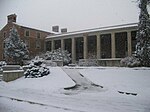Boulder Floral Park Historic District
Buildings and structures in Boulder, ColoradoHistoric districts in Colorado
The Floral Park Historic District is a block of eight homes in Boulder, Colorado that constitute the first planned unit development in Boulder County, Colorado. The homes were built between 1939 and 1940 by a cooperative of eight professors from the nearby University of Colorado, and designated as an historic district by the City of Boulder in 1978.
Excerpt from the Wikipedia article Boulder Floral Park Historic District (License: CC BY-SA 3.0, Authors).Boulder Floral Park Historic District
Bluebell Avenue, Boulder
Geographical coordinates (GPS) Address Nearby Places Show on map
Geographical coordinates (GPS)
| Latitude | Longitude |
|---|---|
| N 39.9977 ° | E -105.2731 ° |
Address
Bluebell Avenue 1549
80302 Boulder
Colorado, United States
Open on Google Maps






